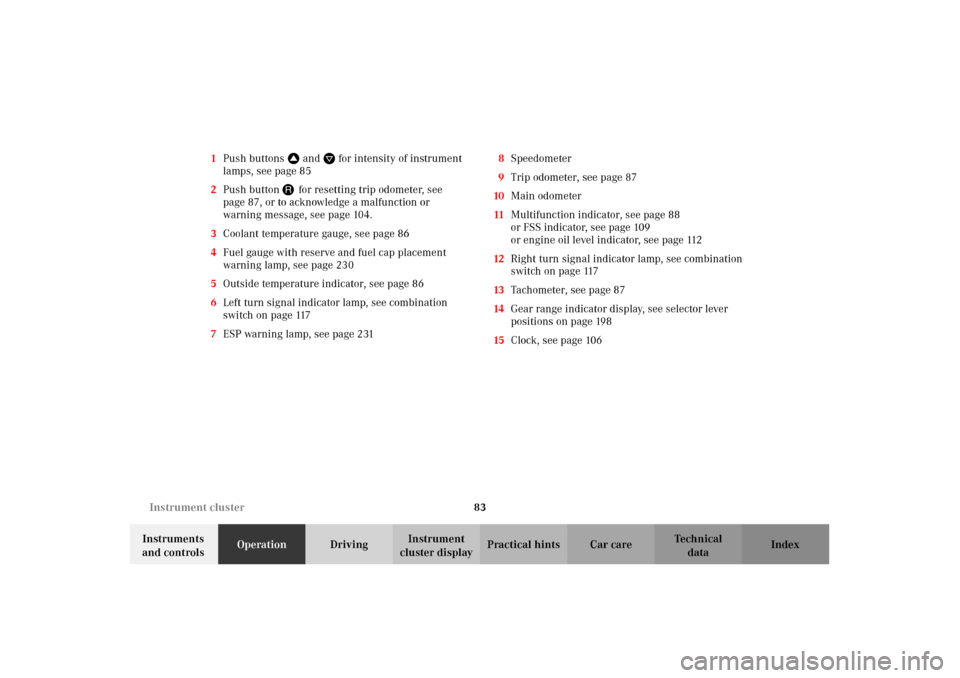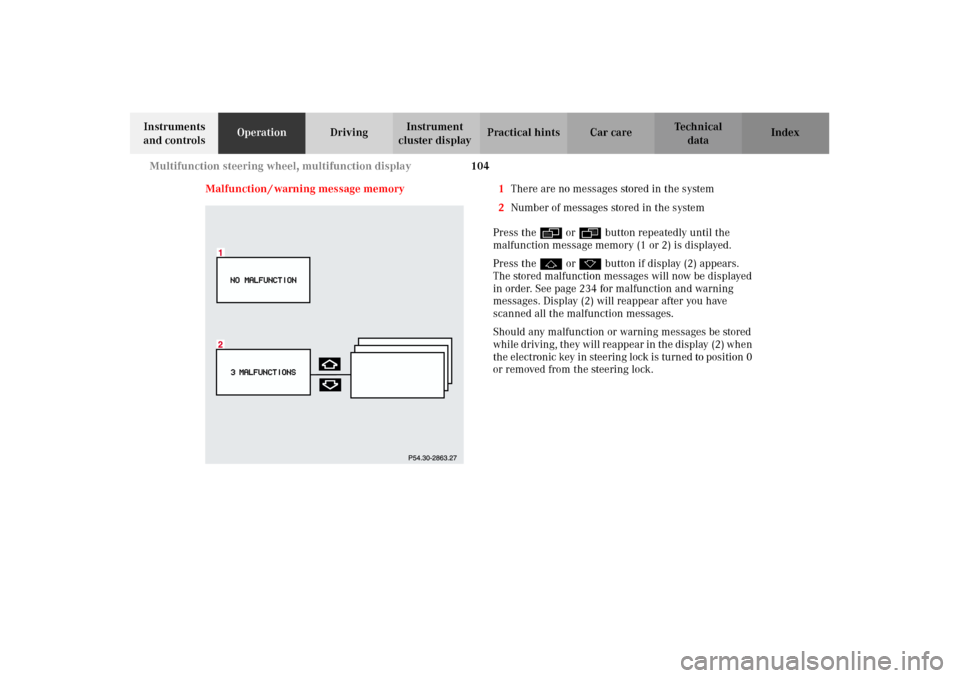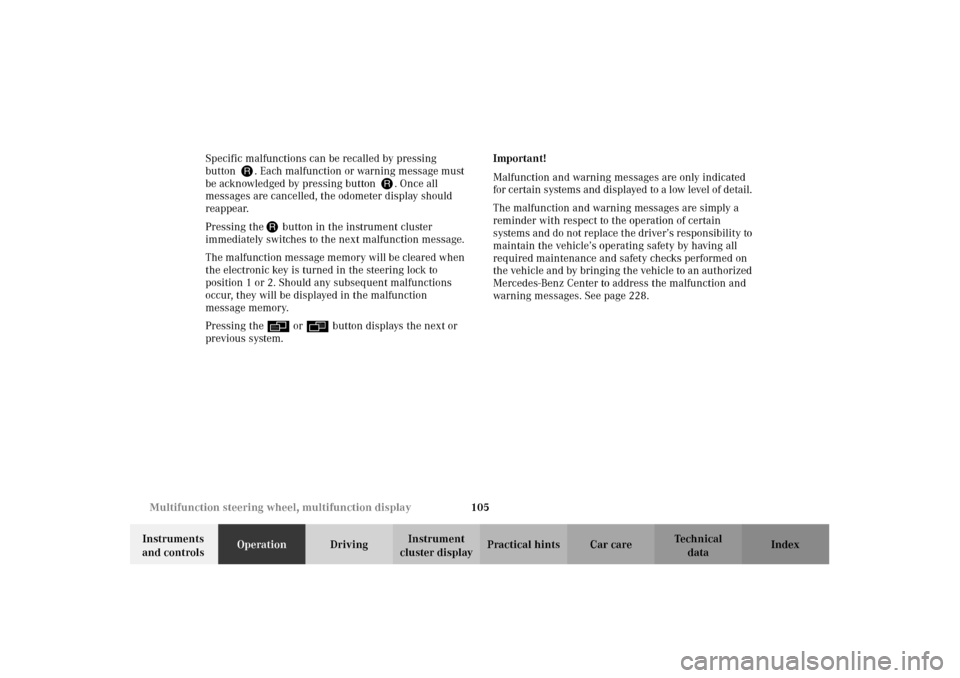2002 MERCEDES-BENZ CLK430 CABRIOLET warning
[x] Cancel search: warningPage 26 of 346

23 Contents – Operation
Technical
data Instruments
and controlsOperationDrivingInstrument
cluster displayPractical hints Car care Index Telephone .......................................... 96
Telephone book ............................ 96
Redialing ....................................... 98
Incoming call .............................. 100
Navigation system .......................... 101
Trip computer ................................. 102
Malfunction/warning
message memory ...................... 104
Individual settings ......................... 106
Setting the audio volume .............. 108
Flexible service system
(FSS) ............................................ 109
Engine oil level indicator .............. 112
Engine oil consumption .................113
Exterior lamp switch ......................114
Night security illumination ..........115
Headlamp cleaning system ...........116
Combination switch .......................117
Hazard warning flasher
switch ...........................................119Automatic climate control ............ 120
Display and controls ................. 122
Basic setting ............................... 122
Economy ...................................... 123
Special settings .......................... 123
Rear window defroster .............. 124
Air recirculation ........................ 125
Residual engine heat
utilization .................................... 125
Dust filter .................................... 126
Audio and telephone,
operation .................................... 127
Power windows .............................. 146
Interior lighting ............................. 149
Sun visors ........................................150
Illuminated vanity mirrors ...........150
Interior ............................................. 151
Storage compartments, armrest
and cup holder ........................... 151
Glove box ...................................... 151Ashtray ............................................ 154
Lighter ............................................. 155
Cargo tie down rings ..................... 156
Parcel net in front
passenger footwell .................... 156
Armrest, rear bench ...................... 156
Telephone, general ........................ 157
Cellular telephone ......................... 157
Garage door opener ....................... 158
Soft top ............................................ 162
Wind screen .................................... 170
J_A208.book Seite 23 Donnerstag, 31. Mai 2001 9:35 09
Page 56 of 346

53 Seats
Technical
data Instruments
and controlsOperationDrivingInstrument
cluster displayPractical hints Car care Index Switch for roll bar and head restraints, rear
The switch is located in the center console.
Turn electronic key in steering lock to position 2.
Press switch:
1Raise roll bar
2Lower roll bar
The lowering or raising procedure is immediately
interrupted by releasing the roll bar switch. With the engine running and the roll bar lowered, the
warning lamp in the roll bar switch will blink for
approx. 15 seconds. The blinking is reminding you to
raise the roll bar if the rear passenger seats are
occupied. See also page 233 for roll bar warning lamp.
Important!
The roll bar is intended to be a safety enhancement to
the other features designed into the vehicle. No system
in any vehicle can eliminate the possibility of serious
injury or fatality in an accident. Properly fastened seat
belts and child restraints must be used!
Notes:
If the warning lamp in the switch comes on, then a
malfunction has been detected. In this case, drive only
with the roll bar raised until the problem has been
corrected. Raise the roll bar by pressing the upper half
of the roll bar switch.
Have the system checked at your authorized
Mercedes-Benz Center as soon as possible.
Items being transported in the rear passenger
compartment should be placed in such a manner as not
to affect the movement of the roll bar when being
raised.
P91.59-2001-26
12
J_A208.book Seite 53 Donnerstag, 31. Mai 2001 9:35 09
Page 62 of 346

59 Restraint systems
Technical
data Instruments
and controlsOperationDrivingInstrument
cluster displayPractical hints Car care Index Note:
For cleaning and care of the seat belts, see page 306.
Seat belt nonusage warning system
With the electronic key in steering lock position 2, a
warning sounds for a short time if the driver’s seat belt
is not fastened. See also seat belt warning lamp on
page 232.
Wa r n i n g !
Never ride in a moving vehicle with the backrest
reclined. Sitting in an excessively reclined position
can be dangerous. You could slide under the seat
belt in a collision. If you slide under it, the belt
would apply force at the abdomen or neck. That
could cause serious or even fatal injuries. The
backrest and seat belt provide the best restraint
when the wearer is in an upright position and the
belt is properly positioned on the body.
Wa r n i n g !
Failure to wear and properly fasten and position
your seat belt greatly increases your risk of
injuries and their likely severity in an accident.
You and your passengers should always wear seat
belts.If you are ever in an accident, your injuries can be
considerably more severe without your seat belt
properly buckled. Without your seat belt buckled,
you are much more likely to hit the interior of the
vehicle or be ejected from it. You can be seriously
injured or killed.In the same crash, the possibility for injury or
death is lessened if you are wearing your seat belt.Wa r n i n g !
Never let more people ride in the vehicle than there
are seat belts available. Be sure everyone riding in
the vehicle is correctly restrained with a separate
seat belt.
J_A208.book Seite 59 Donnerstag, 31. Mai 2001 9:35 09
Page 78 of 346

75 Restraint systems
Technical
data Instruments
and controlsOperationDrivingInstrument
cluster displayPractical hints Car care Index Infant and child restraint systems
We recommend all infants and children be properly re-
strained at all times while the vehicle is in motion. All
lap-shoulder belts except the driver’s seat belt have
special seat belt retractors for secure fastening of child
restraints.
To activate, pull shoulder belt out completely and let it
retract. During the seat belt retraction a ratcheting
sound can be heard to indicate that the special seat belt
retractor is activated. The belt is now locked.
To deactivate, release seat belt buckle and let seat belt
retract completely. The seat belt can again be used in
the usual manner.Important!
The use of infant or child restraints is required by law in
all 50 states and all Canadian provinces.
Infants and small children should be seated in an
appropriate infant or child restraint system properly
secured by a lap-shoulder belt, and that complies with
U.S. Federal Motor Vehicle Safety Standard 213 and
Canadian Motor Vehicle Safety Standard 213.
A statement by the child restraint manufacturer of
compliance with this standard can be found on the
instruction label on the restraint and in the instruction
manual provided with the restraint.
When using any infant or child restraint system, be sure
to carefully read and follow all manufacturer’s
instructions for installation and use.
Please read and observe warning labels affixed to inside
of vehicle and to infant or child restraints.
Wa r n i n g !
Never release the seat belt buckle while vehicle is
in motion, since the special seat belt retractor will
be deactivated.
J_A208.book Seite 75 Donnerstag, 31. Mai 2001 9:35 09
Page 86 of 346

83 Instrument cluster
Technical
data Instruments
and controlsOperationDrivingInstrument
cluster displayPractical hints Car care Index 1Push buttonsVandWfor intensity of instrument
lamps, see page 85
2Push buttonJ for resetting trip odometer, see
page 87, or to acknowledge a malfunction or
warning message, see page 104.
3Coolant temperature gauge, see page 86
4Fuel gauge with reserve and fuel cap placement
warning lamp, see page 230
5Outside temperature indicator, see page 86
6Left turn signal indicator lamp, see combination
switch on page 117
7ESP warning lamp, see page 2318Speedometer
9Trip odometer, see page 87
10Main odometer
11Multifunction indicator, see page 88
or FSS indicator, see page 109
or engine oil level indicator, see page 112
12Right turn signal indicator lamp, see combination
switch on page 117
13Tachometer, see page 87
14Gear range indicator display, see selector lever
positions on page 198
15Clock, see page 106
J_A208.book Seite 83 Donnerstag, 31. Mai 2001 9:35 09
Page 89 of 346

86 Instrument cluster
Technical
data Instruments
and controlsOperationDrivingInstrument
cluster displayPractical hints Car care Index
Coolant temperature gauge (3)
During severe operating conditions and stop-and-go city
traffic, the coolant temperature may rise close to the red
marking.
The engine should not be operated with the coolant
temperature in the red zone. Doing so may cause
serious engine damage which is not covered by the
Mercedes-Benz Limited Warranty.Outside temperature indicator (5)
The temperature sensor is located in the front bumper
area. Due to its location, the sensor can be affected by
road or engine heat during idling or slow driving. This
means that the accuracy of the displayed temperature
can only be verified by comparison to a thermometer
placed next to the sensor, not by comparison to external
displays (e.g. bank signs etc.).
Adaptation to ambient temperature takes place in steps
and depends on the prevailing driving conditions (stop-
and-go or moderate, constant driving) and amount of
temperature change.
Wa r n i n g !
• Driving when your engine is badly overheated
can cause some fluids which may have leaked
into the engine compartment to catch fire. You
could be seriously burned.• Steam from an overheated engine can cause
serious burns and can occur just by opening
the engine hood. Stay away from the engine if
you see or hear steam coming from it.Turn off the engine, get out of the vehicle and do
not stand near the vehicle until it cools down.
Wa r n i n g !
The outside temperature indicator is not designed
to serve as an Ice-Warning Device and is therefore
unsuitable for that purpose. Indicated
temperatures just above the freezing point do not
guarantee that the road surface is free of ice.
J_A208.book Seite 86 Donnerstag, 31. Mai 2001 9:35 09
Page 107 of 346

104 Multifunction steering wheel, multifunction display
Technical
data Instruments
and controlsOperationDrivingInstrument
cluster displayPractical hints Car care Index
Malfunction / warning message memory 1There are no messages stored in the system
2Number of messages stored in the system
Press the è or ÿ button repeatedly until the
malfunction message memory (1 or 2) is displayed.
Press the j or k button if display (2) appears.
The stored malfunction messages will now be displayed
in order. See page 234 for malfunction and warning
messages. Display (2) will reappear after you have
scanned all the malfunction messages.
Should any malfunction or warning messages be stored
while driving, they will reappear in the display (2) when
the electronic key in steering lock is turned to position 0
or removed from the steering lock.
J_A208.book Seite 104 Donnerstag, 31. Mai 2001 9:35 09
Page 108 of 346

105 Multifunction steering wheel, multifunction display
Technical
data Instruments
and controlsOperationDrivingInstrument
cluster displayPractical hints Car care Index Specific malfunctions can be recalled by pressing
button J. Each malfunction or warning message must
be acknowledged by pressing button J. Once all
messages are cancelled, the odometer display should
reappear.
Pressing the J button in the instrument cluster
immediately switches to the next malfunction message.
The malfunction message memory will be cleared when
the electronic key is turned in the steering lock to
position 1 or 2. Should any subsequent malfunctions
occur, they will be displayed in the malfunction
message memory.
Pressing the è or ÿ button displays the next or
previous system.Important!
Malfunction and warning messages are only indicated
for certain systems and displayed to a low level of detail.
The malfunction and warning messages are simply a
reminder with respect to the operation of certain
systems and do not replace the driver’s responsibility to
maintain the vehicle’s operating safety by having all
required maintenance and safety checks performed on
the vehicle and by bringing the vehicle to an authorized
Mercedes-Benz Center to address the malfunction and
warning messages. See page 228.
J_A208.book Seite 105 Donnerstag, 31. Mai 2001 9:35 09